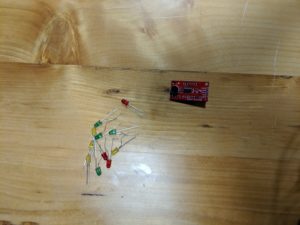My mother will hate me for this, but I have to say it: I come from a loud house. So it only makes sense to let myself know how loud since I would be drowning in noise anyway. I used the following code to connect a sound sensor to a series of LEDs that light up in sequence the louder the sound. In started with three, and then distributed the hertz across 9 LEDs after I solidified my logic.
int soundSensor = A0; // select the input pin for the soundSensor
const int ledPinR3 = 13; // select the pin for the LED
const int ledPinR2 = 12;
const int ledPinR1 = 11;
const int ledPinY3 = 10;
const int ledPinY2 = 9;
const int ledPinY1 = 8;
const int ledPinG3 = 7;
const int ledPinG2 = 6;
const int ledPinG1 = 5;
void setup() {
// put your setup code here, to run once:
//declare the sounSensor as INPUT
pinMode(soundSensor, INPUT);
pinMode(ledPinR1, OUTPUT);
pinMode(ledPinR2, OUTPUT);
pinMode(ledPinR3, OUTPUT);
pinMode(ledPinY1, OUTPUT);
pinMode(ledPinY2, OUTPUT);
pinMode(ledPinY3, OUTPUT);
pinMode(ledPinG1, OUTPUT);
pinMode(ledPinG2, OUTPUT);
pinMode(ledPinG3, OUTPUT);
Serial.begin (9600);
}
void loop() {
// put your main code here, to run repeatedly:
//create an integer to sense the data from the sensor. it is an analog one, so you have to analogRead.
int soundValue = analogRead (soundSensor);
Serial.println(soundValue);
if (soundValue >= 21)
{
digitalWrite (ledPinG1, HIGH);
} else {
digitalWrite (ledPinG1, LOW);
}
if (soundValue >= 70)
{
digitalWrite (ledPinG2, HIGH);
} else {
digitalWrite (ledPinG2, LOW);
}
if (soundValue >= 150)
{
digitalWrite (ledPinG3, HIGH);
} else {
digitalWrite (ledPinG3, LOW);
}
if (soundValue >= 170)
{
digitalWrite (ledPinY1, HIGH);
} else {
digitalWrite (ledPinY1, LOW);
}
if (soundValue >= 210)
{
digitalWrite (ledPinY2, HIGH);
} else {
digitalWrite (ledPinY2, LOW);
}
if (soundValue >= 250)
{
digitalWrite (ledPinY3, HIGH);
} else {
digitalWrite (ledPinY3, LOW);
}
if (soundValue >= 280)
{
digitalWrite (ledPinR1, HIGH);
} else {
digitalWrite (ledPinR1, LOW);
}
if (soundValue >= 310)
{
digitalWrite (ledPinR2, HIGH);
} else {
digitalWrite (ledPinR2, LOW);
}
if (soundValue >= 350)
{
digitalWrite (ledPinR3, HIGH);
} else {
digitalWrite (ledPinR3, LOW);
}
}
We also read some foundational texts regarding design.
Reading Don Norman’s work on affordances and human centered design ironically made me worry about the future of the field. As someone deeply in love with design, Norman’s exceptional ideas about how to design our world expressed, at first, an end to the practice. An exhibit in London described a compelling idea along these lines: that humans are regularly creating a world that no longer requires humans. In the same way, are designers creating a world that no longer requires designers?
Although the thought sparked some initial anxiety, a few ideas in Norman’s text provided some comfort. He expresses that technology and people are constantly evolving and changing. As technology improves, as human behavior changes, the nature of affordances change. What we need as a society change. He also describes, when discussing mapping, that culture can define certain design ideas, and that although some concepts should be universal, others work best for particular societies.
Here, we reach the notion of the zeitgeist, and how we impact it as designers. If culture is constantly shifting and created by us, then maybe the norms of how we view chairs and what they are used for will also change. Changed by our own will. As someone who hopes to enter this design world, I can both be comforted in not only that design will exist and be necessary for as long as I am alive, but also that it will exist and be necessary for as long as humans are alive.

